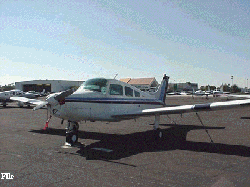Also Faults Pilot For Delay In Applying Carburetor Heat
This report proves that carburetor ice can be a problem no matter where you fly. The NTSB has released the probable cause of an accident that led to the ditching of a Beech Musketeer off the coast of Hawaii. The two people on board the aircraft suffered only minor injuries.

According to the report, 0n May 23, 2016, about 1137 Hawaiian standard time, A Beech C23, N6697Y, sustained substantial damage following a loss of engine power and subsequent ditching within the open waters of the Pacific Ocean near Waianae, Hawaii. The airplane was registered to and operated by the pilot under the provisions of Title 14 Code of Federal Regulations Part 91. The private pilot and his passenger sustained minor injuries. Visual meteorological conditions prevailed and no flight plan was filed for the personal flight. The cross-country flight originated from the Lihue Airport, Lihue, Hawaii, about 20 minutes prior to the accident, with an intended destination of Kalaeloa Airport, Kapolei, Hawaii.
The pilot reported that during the climb to cruise portion of the flight, the engine began to run rough. The pilot applied carburetor heat, which resolved the roughness, and he continued his climb to 5,500 feet mean sea level. As the flight was approaching the shores of Oahu Island, the engine began running rough in addition to a reduction of engine rpm to about 1,700. The pilot applied carburetor heat and adjusted the mixture, however, was unsuccessful at restoring engine power. The pilot initiated a forced landing into the ocean waters just off shore of the island of Oahu.
The airplane came to rest nose low partially submerged within about 20 feet of water, about 50 to 75 feet from the shoreline. Initial examination of the wreckage revealed that the forward portion of the fuselage was damaged. The wreckage was recovered from the water three days after the accident. Following removal from the water, the engine was rinsed with fresh water and subsequently filled with diesel fuel in an attempt to preserve the engine.
The private pilot reported that, during the climb-to-cruise portion of the cross-country interisland flight over open ocean water, the engine began to run roughly. The pilot applied carburetor heat, which resolved the engine roughness. The pilot decided to continue his flight. As the flight approached his destination, the engine began running roughly again, accompanied by a significant loss of engine rpm. The pilot applied carburetor heat and adjusted the mixture, but the engine power was not restored. He then ditched the airplane into the water just offshore of the island.
The airplane wreckage was recovered from the water 3 days after the accident, and it had sustained significant damage from tidal forces. Postaccident examination of the airframe and engine revealed no evidence of mechanical malfunctions or failures that would have precluded normal operation.
Weather conditions in the area at the time of the accident were conducive to the formation of carburetor icing at glide and cruise power and serious carburetor icing at glide power. If the pilot had either kept the carburetor heat on or applied it earlier, the loss of engine power and subsequent ditching could have been avoided.
The NTSB found that the probable cause of this accident to be the total loss of engine power during cruise flight due to carburetor icing. Contributing to the accident was the pilot's delay in applying carburetor heat during flight while operating in an area conducive to carburetor icing.
(Image from file. Not accident airplane)
 ANN's Daily Aero-Term (04.20.24): Light Gun
ANN's Daily Aero-Term (04.20.24): Light Gun Aero-News: Quote of the Day (04.20.24)
Aero-News: Quote of the Day (04.20.24) ANN's Daily Aero-Linx (04.21.24)
ANN's Daily Aero-Linx (04.21.24) Aero-News: Quote of the Day (04.21.24)
Aero-News: Quote of the Day (04.21.24) ANN's Daily Aero-Term (04.21.24): Aircraft Conflict
ANN's Daily Aero-Term (04.21.24): Aircraft Conflict



